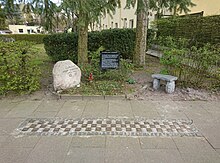Subcamp Hamburg-Langenhorn
The Hamburg-Langenhorn subcamp was a subcamp of the Neuengamme concentration camp in existence from September 1944 to the beginning of May 1945 for initially 500 female prisoners in the north of Hamburg on the border with Schleswig-Holstein . It was located in Hamburg-Langenhorn at Weg 4 (since 1952 Essener Strasse ). The barrack camp was in the immediate vicinity of sites of the arms industry.
prehistory
In the summer of 1944, a section of the camp was separated from an eastern worker camp that had existed on site since 1942 to set up a subcamp for female prisoners. After expansion, there were two barracks with sleeping quarters for prisoners, a kitchen barrack and a small prisoner infirmary in this part of the camp. Immediately next to the entrance to the external camp, the accommodation for the camp staff was set up.
Function of the camp, inmates and camp management
In mid-September 1944, 500 mostly Lithuanian, but also Estonian, Hungarian, Polish, Czech and German Jewish women from the Stutthof concentration camp arrived at the Hamburg-Langenhorn satellite camp . At the beginning of March 1945, 250 female Sinti and Roma as well as prisoner women who were described as “criminal” in Nazi jargon were transferred from the Ravensbrück concentration camp to the Hamburg-Langenhorn satellite camp.
In alternating twelve-hour shifts, the female prisoners had to do forced labor in armaments production for the Hanseatic Chain Works and Deutsche Messapparate GmbH . The women at these companies used machines to manufacture weapons and ammunition, such as bazookas and anti-aircraft bullets. They worked together with prisoners of war and German workers at their locations, but were not allowed to contact one another. The women were taken to the work site of a branch of Deutsche Messapparate GmbH in Schanzenstrasse by S-Bahn . In the end of the war, some female prisoners had to excavate the prefabricated house.
In the camp, the female prisoners were monitored by female guards and outside by a male guards team, some of them made up of customs officers. Walter Lau, an SS man from East Prussia, was the head of the Langenhorn women's subcamp.
On April 3 or 4, 1945, the subcamp was closed and most of the female prisoners were transferred to the Bergen-Belsen concentration camp and some to the Hamburg-Sasel subcamp.
In the course of the clearing of the Neuengamme satellite camps, a train with 50 wagons of female and male prisoners started on April 10 from the Helmstedt-Beendorf satellite camp and drove via Magdeburg , Stendal and Wittenberge to Sülstorf , where the train from 13 to 15 April stopped because a track was blocked. There were 150 to 170 prisoners in each car. Hundreds of prisoners died in the transport with almost no water or food. On the 15th the train finally started and reached the Wöbbelin concentration camp near Ludwigslust , where the male prisoners had to get off. From there the odyssey for women continued. They had to spend another six days in the wagons and were then split up on arrival in Hamburg. Some of them arrived at the Langenhorn satellite camp on April 20, completely weakened. Nine of them died in Langenhorn. On May 3, the women were deported from the Langenhorn camp to the Hamburg-Eidelstedt satellite camp, where they were freed by British soldiers shortly afterwards.
Commemoration
Today, a memorial stone and an information board, which have been at Essener Strasse 54 since 1988, remind of the former storage location . On June 27, 2018, 50 stumbling blocks (49 with names) were laid there. The names refer to the dead infants of women from Belgium, France, Latvia, Lithuania, Poland, Russia, Ukraine and Belarus who had to do forced labor for the arms industry. On March 15, 2019, the wooden bench there was replaced by a stone bench that was financed by the parish of St. Jürgen-Zachäus. Nearby, at the Essener Bogen, there was also a memorial stele erected in 2008 to commemorate the forced laborers of the Hanseatic chain works . June 2020, the stele was moved to a green area on the path to the left of the bus station at the Ochsenzoll underground station and ceremoniously unveiled and handed over on June 9, 2020. Since May 18, 2019, other stumbling blocks reminiscent of two slave laborers have been located on Langenhorner Chaussee 623, not far from the memorial stele.
literature
- Wolfgang Benz , Barbara Distel (ed.): The place of terror . History of the National Socialist Concentration Camps. Volume 5: Hinzert, Auschwitz, Neuengamme. CH Beck, Munich 2007, ISBN 978-3-406-52965-8 , p. 410f.
- Neuengamme Concentration Camp Memorial (ed.): The exhibitions. Edition Temmen , Bremen 2005, ISBN 3-86108-075-3 .
- Michael Holtmann: Housing for the armaments industry - settlements for the Hanseatic chain works and the Messap - Langenhorn and its buildings , Willi-Bredel-Gesellschaft Geschichtswerkstatt eV (publisher), Hamburg 2020, ISBN 978-3-982055992
Web links
- Hamburg-Langenhorn at the Neuengamme Concentration Camp Memorial website.
Individual evidence
- ↑ "Essener Strasse"
- ^ A b c Hans Ellger: Hamburg-Langenhorn . In: Wolfgang Benz, Barbara Distel (eds.): The place of terror. History of the National Socialist Concentration Camps. Volume 5, Hinzert, Auschwitz, Neuengamme. Munich 2007, p. 410f.
- ↑ a b Memorials in Hamburg - memorial stone for the victims of the Hamburg-Langenhorn satellite camp
- ^ Arrival of the women on April 20
- ↑ Hamburg-Langenhorn satellite camp on the Neuengamme Concentration Camp Memorial website.
- ↑ Unveiling 2020 on youtube
Coordinates: 53 ° 40 ′ 20 ″ N , 9 ° 59 ′ 35 ″ E

